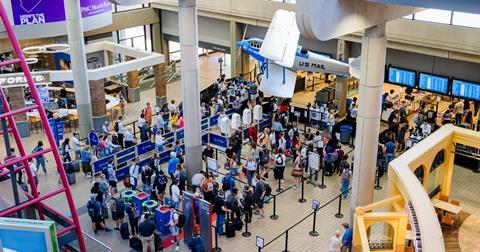US commercial airlines and the Federal Aviation Administration are preparing for the upcoming Independence Day holiday travel period, which is expected to break records.
The FAA said on 24 June that it anticipates Friday, 27 June will be its busiest travel day so far this year, with 53,677 flights scheduled.
The holiday is celebrated in the USA on 4 July. Since that date falls on a Thursday this year, companies often give their employees the following Friday off as well, creating a four-day long weekend for most.

The US regulator says it expects a total of more than 444,500 flights between 26 June and 5 July. It has not released figures for the weekend after the actual holiday, which is also expected to push figures into the record books.
Meantime, the US Transportation Security Administration (TSA), responsible for safety checks at more than 430 airports across the nation, says it is planning to screen ”more than 32 million individuals” from 27 June through 8 July. That’s a 5.4% increase over 2023 travel volumes, the agency says.
Last Sunday, 23 June was TSA’s busiest day ever so far, when it screened 2.99 million people. It expects to break the 3 million-mark on 28 June.
American Airlines, which considers the period between 27 June and 7 July to be its peak holiday travel period, says it plans to welcome more than 7.2 million customers on its aircraft, up 8% from last year.
It says its schedule is “nearly 30% larger than our closest competitor”.
United Airlines says the weekend will be its “busiest on record”. It’s expecting more than 5 million passengers to fly between 28 June and 8 July, up more than 7% from last year’s figures.
The Chicago-based carrier will transport about 520,000 passengers every day, on more than 4,400 flights. “That’s an average of about three take-offs every minute for 11 straight days,” the company says. The airline anticipates its busiest travel days will be 29 June and 7 July.
All told, the airline expects traffic to be about 5% higher during this summer in the northern hemisphere than it was last year.
A year ago, just ahead of the holiday, commercial airlines suffered a service meltdown in the Northeast USA as a result of severe weather coupled with a shortage of air traffic controllers. United’s operation was most affected, leading chief executive Scott Kirby to attack the FAA, saying the agency “failed us”.
For his part, Kirby hopped on a private jet to travel to Denver from the New York City area, rather than suffer the consequences of his airline’s scheduling chaos alongside its customers. On the same day, the carrier had cancelled 751 or 26% of its scheduled flights system-wide, while 1,315 or 45% of all flights were delayed, according to statistics compiled by FlightAware.com.
The FAA has been struggling to keep air traffic control centres, especially the Northeast, fully staffed following Covid-19-related retirements and training bottlenecks. It plans to hire 1,800 new controllers in 2024.


























